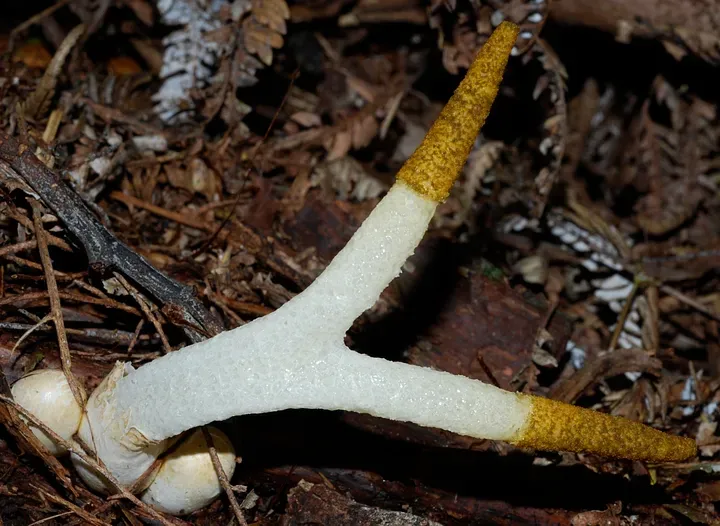Mysteries in the Malaysian Forest: A Tour of Odd Mushrooms
Fungi come in all shapes, sizes, and colors, and Malaysia is a particularly rich country in terms of fungal diversity.
From the small and minuscule to the large and bizarre, the country is home to a wide range of fascinating fungi that can be found in its forests and jungles.
1. Chlorogaster dipterocarpi
Back in '99, some researchers (Thomas Læssøe and Leo Jalink) found an epic new puffball species in the Sabah forest in Malaysia. They tried reaching out to a bunch of fungal experts, but no one could help them identify it.
That's when they realized they had discovered a totally new type of fungus! By examining its physical features, they discovered that this funky fungus - Chlorogaster dipterocarpi - belongs to the same family as other hard-skinned puffballs like Scleroderma and Pisolithus.
Apparently, all of these guys are related to bolete-like mushrooms from way back in the day. But once Chlorogaster dipterocarpi's ancestors went down the puffball path, they couldn't turn back to their mushroom roots.
2. Durianella echinulata
The fungus was originally collected in a jungle in Kemaman, Terengganu (Malaysia), on 24 June 1932, where it grew on soil buried in leaves at a river's edge.
The genus name Durianella refers to the fruit bodies' resemblance to a small durian. Durianella echinulata is found under trees of the Genus Shorea in Peninsular Malaysia and Borneo.
It fruits on the ground singly, scattered, or in small clusters.
The blue staining suggested a relationship with Gyroporus, while the structure of the fruit bodies suggested an affinity with Pisolithus. The Genus contains the single species Durianella echinulata, described in 2008, and is placed on the IUCN Red List.
3. Spongiforma squarepantsii
The name of the fungus is derived from the Nickelodeon cartoon character SpongeBob SquarePants from the show of the same name.
S. squarepantsii is one of two species in Spongiforma; it differs from S. thailandica in its color, odor, and spore structure.
“It’s just like a sponge with these big hollow holes. When it’s wet and moist and fresh, you can wring water out of it and it will spring back to its original size. Most mushrooms don’t do that.” - Dennis Desjardin
© Suzanne Ou - S. squarepantsii is shaped like a sea sponge and, say its discoverers, has a fruity or musty smell.
This species is only confirmed to be found in the dipterocarp-dominated forest of the Lambir Hills in Sarawak, Malaysia. There is an unpublished and unconfirmed record from Peninsular Malaysia by Su-See Lee.
4. Entoloma caespitosum group
Similar looking to the pink Entoloma mastoideum, these purple-capped mushrooms are reported to be some of the most toxic of the Genus (which has a global reach of over 1,000 species).
5. Aureoboletus longicollis
Another oddity.
6. Pointy Pink Bolete
7. Clathrus delicatus
The minuscule size and seeing the rhizoids cover a branch to produce pouches reminds me of some kind of Lycoperdon and Geastrum (tiny earthstars) when young.
Clathrus delicatus is a species of fungus in the stinkhorn family known mainly from Sri Lanka and India.
8. Bioluminescent Mycena sp.
Malaysia has the most recorded species of bioluminescent mushrooms in the world (+25 out of ~113). Many new unnamed species are being discovered here, such as this Mycena:
Unidentified bioluminescent Mycena sp. - © Frank Walther
9. Xylaria schweinitzii
This species was only recorded once in Malaysia on iNaturalist about 9 years ago. These were found growing under a wooden support beam used on a trail at Taman Tugu. They appeared like berries (dark blueberry color).
This Xylaria is very "inky" and stains your fingers when touched.
I left this guy in a small container for a while, and when I checked again, the bottom was filled with ink. After a couple of days, it completely liquified and produced enough ink to probably write all this by hand.
A closer look at the surface shows accumulations of conidia from the asexual state.
10. Mutinus borneensis
Collected in Borneo (hence the epithet ‘borneensis’), this “dog stinkhorn” is one of a few species of Mutinus recorded in Malaysia.
The eggs are deemed edible at an early stage.
11. Hydnum / Hedgehog Mushroom
Toothed fungi are interesting, and this one especially! I've never seen a multi-stiped / headed Medusa-like hedgehog morphology before.
Photo credit: siew.g.tan
Considered a choice edible mushroom. The hedgehog has a sweet, nutty flavor and a nice, chewy texture. Another name for the hedgehog mushroom is "sweet tooth."
12. Pseudoclathrus cylindrosporus
A Cage Fungus (Pseudoclathrus cylindrosporus) grows in the rich decaying humus of Mount Kinabalu's montane rainforest.
Flies, which are attracted to the strong putrid odor, disperse the spores, which are found in a brown slime secreted on the inner surface of the receptaculum.
Malaysia is home to a wide range of fascinating and unique fungus species that are still being discovered and studied by scientists and enthusiasts alike.
Every year, new and exciting fungal species like this are discovered, underscoring the vastness of our knowledge gap within this remarkable kingdom. The diversity of fungi in tropical rainforests has only been superficially explored, and this should be a thrilling prospect for those who study the forest floor, as countless species remain undiscovered.


-SL30.jpg)
.png)
.png)




















Comments
Post a Comment